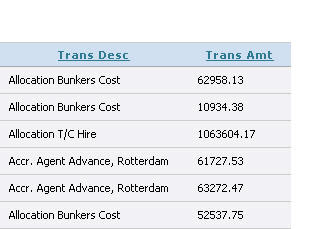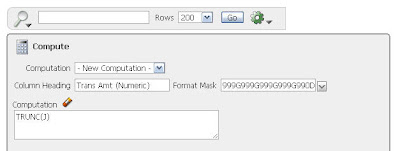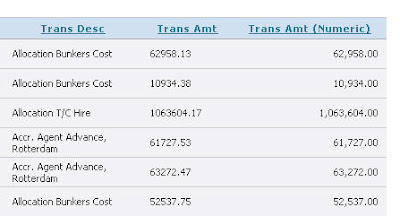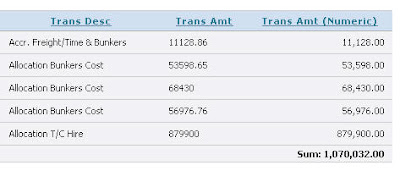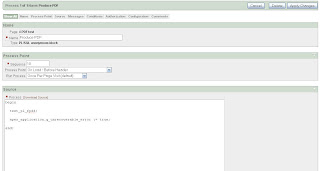In today's globalized world, being able to communicate in different languages is important. Personally, I'm struggling to get my level of Spanish above the "una cerveza, por favor" level, and Google Translate is a great tool that I use often.
Wouldn't it be great to have the power of Google Translate directly from SQL? Google exposes the translation service via a RESTful (JSON) API, so I decided to write a small PL/SQL wrapper for it.
Here is the package specification:
create or replace package google_translate_pkg as /* Purpose: PL/SQL wrapper package for Google Translate API Remarks: see http://code.google.com/apis/ajaxlanguage/documentation/ Who Date Description ------ ---------- ------------------------------------- MBR 25.12.2009 Created */ -- http://code.google.com/apis/ajaxlanguage/documentation/reference.html#LangNameArray g_lang_AFRIKAANS constant varchar2(5) := 'af'; g_lang_ALBANIAN constant varchar2(5) := 'sq'; g_lang_AMHARIC constant varchar2(5) := 'am'; g_lang_ARABIC constant varchar2(5) := 'ar'; g_lang_ARMENIAN constant varchar2(5) := 'hy'; g_lang_AZERBAIJANI constant varchar2(5) := 'az'; g_lang_BASQUE constant varchar2(5) := 'eu'; g_lang_BELARUSIAN constant varchar2(5) := 'be'; g_lang_BENGALI constant varchar2(5) := 'bn'; g_lang_BIHARI constant varchar2(5) := 'bh'; g_lang_BULGARIAN constant varchar2(5) := 'bg'; g_lang_BURMESE constant varchar2(5) := 'my'; g_lang_CATALAN constant varchar2(5) := 'ca'; g_lang_CHEROKEE constant varchar2(5) := 'chr'; g_lang_CHINESE constant varchar2(5) := 'zh'; g_lang_CHINESE_SIMPLIFIED constant varchar2(5) := 'zh-CN'; g_lang_CHINESE_TRADITIONAL constant varchar2(5) := 'zh-TW'; g_lang_CROATIAN constant varchar2(5) := 'hr'; g_lang_CZECH constant varchar2(5) := 'cs'; g_lang_DANISH constant varchar2(5) := 'da'; g_lang_DHIVEHI constant varchar2(5) := 'dv'; g_lang_DUTCH constant varchar2(5) := 'nl'; g_lang_ENGLISH constant varchar2(5) := 'en'; g_lang_ESPERANTO constant varchar2(5) := 'eo'; g_lang_ESTONIAN constant varchar2(5) := 'et'; g_lang_FILIPINO constant varchar2(5) := 'tl'; g_lang_FINNISH constant varchar2(5) := 'fi'; g_lang_FRENCH constant varchar2(5) := 'fr'; g_lang_GALICIAN constant varchar2(5) := 'gl'; g_lang_GEORGIAN constant varchar2(5) := 'ka'; g_lang_GERMAN constant varchar2(5) := 'de'; g_lang_GREEK constant varchar2(5) := 'el'; g_lang_GUARANI constant varchar2(5) := 'gn'; g_lang_GUJARATI constant varchar2(5) := 'gu'; g_lang_HEBREW constant varchar2(5) := 'iw'; g_lang_HINDI constant varchar2(5) := 'hi'; g_lang_HUNGARIAN constant varchar2(5) := 'hu'; g_lang_ICELANDIC constant varchar2(5) := 'is'; g_lang_INDONESIAN constant varchar2(5) := 'id'; g_lang_INUKTITUT constant varchar2(5) := 'iu'; g_lang_IRISH constant varchar2(5) := 'ga'; g_lang_ITALIAN constant varchar2(5) := 'it'; g_lang_JAPANESE constant varchar2(5) := 'ja'; g_lang_KANNADA constant varchar2(5) := 'kn'; g_lang_KAZAKH constant varchar2(5) := 'kk'; g_lang_KHMER constant varchar2(5) := 'km'; g_lang_KOREAN constant varchar2(5) := 'ko'; g_lang_KURDISH constant varchar2(5) := 'ku'; g_lang_KYRGYZ constant varchar2(5) := 'ky'; g_lang_LAOTHIAN constant varchar2(5) := 'lo'; g_lang_LATVIAN constant varchar2(5) := 'lv'; g_lang_LITHUANIAN constant varchar2(5) := 'lt'; g_lang_MACEDONIAN constant varchar2(5) := 'mk'; g_lang_MALAY constant varchar2(5) := 'ms'; g_lang_MALAYALAM constant varchar2(5) := 'ml'; g_lang_MALTESE constant varchar2(5) := 'mt'; g_lang_MARATHI constant varchar2(5) := 'mr'; g_lang_MONGOLIAN constant varchar2(5) := 'mn'; g_lang_NEPALI constant varchar2(5) := 'ne'; g_lang_NORWEGIAN constant varchar2(5) := 'no'; g_lang_ORIYA constant varchar2(5) := 'or'; g_lang_PASHTO constant varchar2(5) := 'ps'; g_lang_PERSIAN constant varchar2(5) := 'fa'; g_lang_POLISH constant varchar2(5) := 'pl'; g_lang_PORTUGUESE constant varchar2(5) := 'pt-PT'; g_lang_PUNJABI constant varchar2(5) := 'pa'; g_lang_ROMANIAN constant varchar2(5) := 'ro'; g_lang_RUSSIAN constant varchar2(5) := 'ru'; g_lang_SANSKRIT constant varchar2(5) := 'sa'; g_lang_SERBIAN constant varchar2(5) := 'sr'; g_lang_SINDHI constant varchar2(5) := 'sd'; g_lang_SINHALESE constant varchar2(5) := 'si'; g_lang_SLOVAK constant varchar2(5) := 'sk'; g_lang_SLOVENIAN constant varchar2(5) := 'sl'; g_lang_SPANISH constant varchar2(5) := 'es'; g_lang_SWAHILI constant varchar2(5) := 'sw'; g_lang_SWEDISH constant varchar2(5) := 'sv'; g_lang_TAJIK constant varchar2(5) := 'tg'; g_lang_TAMIL constant varchar2(5) := 'ta'; g_lang_TAGALOG constant varchar2(5) := 'tl'; g_lang_TELUGU constant varchar2(5) := 'te'; g_lang_THAI constant varchar2(5) := 'th'; g_lang_TIBETAN constant varchar2(5) := 'bo'; g_lang_TURKISH constant varchar2(5) := 'tr'; g_lang_UKRAINIAN constant varchar2(5) := 'uk'; g_lang_URDU constant varchar2(5) := 'ur'; g_lang_UZBEK constant varchar2(5) := 'uz'; g_lang_UIGHUR constant varchar2(5) := 'ug'; g_lang_VIETNAMESE constant varchar2(5) := 'vi'; g_lang_WELSH constant varchar2(5) := 'cy'; g_lang_YIDDISH constant varchar2(5) := 'yi'; g_lang_UNKNOWN constant varchar2(5) := ''; -- translate a piece of text function translate_text (p_text in varchar2, p_to_lang in varchar2, p_from_lang in varchar2 := null, p_use_cache in varchar2 := 'YES') return varchar2; -- detect language code for text function detect_lang (p_text in varchar2) return varchar2; -- get number of texts in cache function get_translation_cache_count return number; -- clear translation cache procedure clear_translation_cache; end google_translate_pkg; /
And here is the package body:
create or replace package body google_translate_pkg
as
/*
Purpose: PL/SQL wrapper package for Google Translate API
Remarks: see http://code.google.com/apis/ajaxlanguage/documentation/
Who Date Description
------ ---------- -------------------------------------
MBR 25.12.2009 Created
*/
m_http_referrer constant varchar2(255) := 'your-domain-name-or-website-here'; -- insert your domain/website here (required by Google's terms of use)
m_api_key constant varchar2(255) := null; -- insert your Google API Key here (optional but recommended)
m_service_url constant varchar2(255) := 'http://ajax.googleapis.com/ajax/services/language/';
m_service_version constant varchar2(10) := '1.0';
m_max_text_size constant pls_integer := 500; -- can be increased up towards 32k, the cache name size (below) must be increased accordingly
type t_translation_cache is table of varchar2(32000) index by varchar2(550);
m_translation_cache t_translation_cache;
m_cache_id_separator constant varchar2(1) := '|';
procedure add_to_cache (p_from_text in varchar2,
p_from_lang in varchar2,
p_to_text in varchar2,
p_to_lang in varchar2)
as
begin
/*
Purpose: add translation to cache
Remarks:
Who Date Description
------ ---------- -------------------------------------
MBR 25.12.2009 Created
*/
m_translation_cache (p_from_lang || m_cache_id_separator || p_to_lang || m_cache_id_separator || replace(substr(p_from_text,1,m_max_text_size), m_cache_id_separator, '')) := p_to_text;
end add_to_cache;
function get_from_cache (p_text in varchar2,
p_from_lang in varchar2,
p_to_lang in varchar2) return varchar2
as
l_returnvalue varchar2(32000);
begin
/*
Purpose: get translation from cache
Remarks:
Who Date Description
------ ---------- -------------------------------------
MBR 25.12.2009 Created
*/
begin
l_returnvalue := m_translation_cache (p_from_lang || m_cache_id_separator || p_to_lang || m_cache_id_separator || replace(substr(p_text,1,m_max_text_size), m_cache_id_separator, ''));
exception
when no_data_found then
l_returnvalue := null;
end;
return l_returnvalue;
end get_from_cache;
function get_clob_from_http_post (p_url in varchar2,
p_values in varchar2) return clob
as
l_request utl_http.req;
l_response utl_http.resp;
l_buffer varchar2(32767);
l_returnvalue clob := ' ';
begin
/*
Purpose: do a HTTP POST and get results back in a CLOB
Remarks:
Who Date Description
------ ---------- -------------------------------------
MBR 25.12.2009 Created
*/
l_request := utl_http.begin_request (p_url, 'POST', utl_http.http_version_1_1);
utl_http.set_header (l_request, 'Referer', m_http_referrer); -- note that the actual header name is misspelled in the HTTP protocol
utl_http.set_header (l_request, 'Content-Type', 'application/x-www-form-urlencoded');
utl_http.set_header (l_request, 'Content-Length', to_char(length(p_values)));
utl_http.write_text (l_request, p_values);
l_response := utl_http.get_response (l_request);
if l_response.status_code = utl_http.http_ok then
begin
loop
utl_http.read_text (l_response, l_buffer);
dbms_lob.writeappend (l_returnvalue, length(l_buffer), l_buffer);
end loop;
exception
when utl_http.end_of_body then
null;
end;
end if;
utl_http.end_response (l_response);
return l_returnvalue;
end get_clob_from_http_post;
function translate_text (p_text in varchar2,
p_to_lang in varchar2,
p_from_lang in varchar2 := null,
p_use_cache in varchar2 := 'YES') return varchar2
as
l_values varchar2(2000);
l_response clob;
l_start_pos pls_integer;
l_end_pos pls_integer;
l_returnvalue varchar2(32000) := null;
begin
/*
Purpose: translate a piece of text
Remarks: if the "from" language is left blank, Google Translate will attempt to autodetect the language
Who Date Description
------ ---------- -------------------------------------
MBR 25.12.2009 Created
MBR 25.12.2009 Added cache for translations
*/
if trim(p_text) is not null then
if p_use_cache = 'YES' then
l_returnvalue := get_from_cache (p_text, p_from_lang, p_to_lang);
end if;
if l_returnvalue is null then
l_values := 'v=' || m_service_version || '&q=' || utl_url.escape (substr(p_text,1,m_max_text_size), false, 'UTF8') || '&langpair=' || p_from_lang || '|' || p_to_lang;
if m_api_key is not null then
l_values := l_values || '&key=' || m_api_key;
end if;
l_response := get_clob_from_http_post (m_service_url || 'translate', l_values);
if l_response is not null then
l_start_pos := instr(l_response, '{"translatedText":"');
l_start_pos := l_start_pos + 19;
l_end_pos := instr(l_response, '"', l_start_pos);
l_returnvalue := substr(l_response, l_start_pos, l_end_pos - l_start_pos);
if (p_use_cache = 'YES') and (l_returnvalue is not null) then
add_to_cache (p_text, p_from_lang, l_returnvalue, p_to_lang);
end if;
end if;
end if;
end if;
return l_returnvalue;
end translate_text;
function detect_lang (p_text in varchar2) return varchar2
as
l_url varchar2(2000);
l_response clob;
l_start_pos pls_integer;
l_end_pos pls_integer;
l_returnvalue varchar2(255);
begin
/*
Purpose: detect language code for text
Remarks:
Who Date Description
------ ---------- -------------------------------------
MBR 25.12.2009 Created
*/
if trim(p_text) is not null then
l_url := m_service_url || 'detect?v=' || m_service_version || '&q=' || utl_url.escape (substr(p_text,1,m_max_text_size), false, 'UTF8');
if m_api_key is not null then
l_url := l_url || '&key=' || m_api_key;
end if;
l_response := httpuritype(l_url).getclob();
l_start_pos := instr(l_response, '{"language":"');
l_start_pos := l_start_pos + 13;
l_end_pos := instr(l_response, '",', l_start_pos);
l_returnvalue := substr(l_response, l_start_pos, l_end_pos - l_start_pos);
end if;
return l_returnvalue;
end detect_lang;
function get_translation_cache_count return number
as
l_returnvalue number;
begin
/*
Purpose: get number of texts in cache
Remarks:
Who Date Description
------ ---------- -------------------------------------
MBR 25.12.2009 Created
*/
l_returnvalue := m_translation_cache.count;
return l_returnvalue;
end get_translation_cache_count;
procedure clear_translation_cache
as
begin
/*
Purpose: clear translation cache
Remarks:
Who Date Description
------ ---------- -------------------------------------
MBR 25.12.2009 Created
*/
m_translation_cache.delete;
end clear_translation_cache;
end google_translate_pkg;
/
So, let's take the package for a test drive!
Detecting languages
Google can (try to) figure out which language a specific text is in.
select google_translate_pkg.detect_lang ('hola mundo') as detect1,
google_translate_pkg.detect_lang ('ich bin ein berliner') as detect2
from dual
detect1 detect2
-------------------- --------------------
es de
1 row selected.
Translating text
This is the most common usage of the package. Note that if you leave out the "from" language parameter, Google will attempt to autodetect the language.
select google_translate_pkg.translate_text ('excuse me, where is the toilet?', 'es') as the_phrase
from dual
the_phrase
----------------------------------------
Disculpe, ¿dónde está el baño?
1 row selected.
Mass translation
Here is an example that translates several rows -- the product descriptions from the demo products table (from the Application Express demo application) -- into several languages.
select pi.product_id, pi.product_name, pi.product_description, google_translate_pkg.translate_text (pi.product_description, 'es', 'en') as spanish_description, google_translate_pkg.translate_text (pi.product_description, 'de', 'en') as german_description from demo_product_info pi order by pi.product_name product_id product_name product_description spanish_description german_description ---------- -------------------- ------------------------------ ------------------------------ ------------------------------ 3 Bluetooth Headset Hands-Free without the wires! Manos libres sin cables! Hands-Free ohne Kabel! 8 Classic Projector Does not include transparencie No incluye transparencias o lá Enthält keine Folien oder Fett s or grease pencil piz de grasa stift 2 MP3 Player Store up to 1000 songs and tak Almacena hasta 1000 canciones Speichern Sie bis zu 1000 Song e them with you y llevarlos con usted s, und nehmen Sie sie mit 4 PDA Cell Phone Combine your cell phone and PD Combine su teléfono celular y Kombinieren Sie Ihre Handy und A into one device PDA en un solo dispositivo PDA in einem Gerät 5 Portable DVD Player Small enough to take anywhere! Lo suficientemente pequeño com Klein genug, um überall hin mi o para tener en cualquier luga tnehmen! r! tnehmen! 10 Stereo Headphones Noise-cancelling headphones pe El ruido auriculares con perfe Noise-Cancelling-Kopfhörer ide rfect for the traveler cta para el viajero al für den Reisenden 9 Ultra Slim Laptop The power of a desktop in a po El poder de una computadora de Die Leistung eines Desktop in rtable design escritorio en un diseño portá ein tragbares Design rtable design til ein tragbares Design 1 3.2 GHz Desktop PC All the options, this machine Todas las opciones, se carga e Alle Optionen, ist diese Masch is loaded! sta máquina! ine geladen! 6 512 MB DIMM Expand your PCs memory and gai Amplíe su PC la memoria y obte Erweitern Sie Ihren PC Speiche n more performance ner más rendimiento r und gewinnen mehr Leistung 7 54" Plasma Flat Scre Mount on the wall or ceiling, Montar en la pared o el techo, Montage auf der Wand oder Deck en the picture is crystal clear! el panorama es claro! e, das Bild ist glasklar! 10 rows selected.
Apex translation
Combine this package with the Apex dictionary views to get a kick-start when you are translating your own Apex applications into other languages (some tweaking of the results is probably necessary...).
select item_name, label, google_translate_pkg.translate_text (label, 'es', 'en') as spanish_label, google_translate_pkg.translate_text (label, 'nl', 'en') as dutch_label from apex_application_page_items where application_id = 103 and label is not null and display_as <> 'Hidden' item_name label spanish_label dutch_label -------------------- -------------------- -------------------- -------------------- P101_PASSWORD Password Contraseña Wachtwoord P101_USERNAME User Name Nombre de usuario Gebruikersnaam P11_CUSTOMER_ID Customer Cliente Klant P29_CUSTOMER_INFO Customer Info Información del clie Customer Info nte P29_ORDER_TIMESTAMP Order Date Fecha de pedido Orderdatum P29_ORDER_TOTAL Order Total Orden total Bestel Totaal P29_USER_ID Sales Rep Sales Rep Vertegenwoordiger 7 rows selected.
Caching
I have built in a simple cache mechanism, so that you avoid the network traffic if the phrase has already been translated in your current session (and the performance benefit can be huge if you repeatedly translate the same strings).
You can specify whether you want to use the cache (it's on by default), and there is also a procedure to clear (reset) the cache.
Conclusion
It is time to throw out your old-fashioned dictionaries and fire up SQL Plus instead :-)







